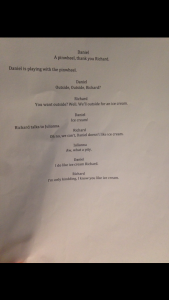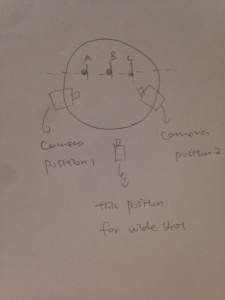Investigation of Mise-en-Scene, Montage, Decoupage
Mise-en-Scene:
The vagueness definition of Mise-en-Scene means “put thing into the scene”, which origin in French. Firstly, it was used in practice of directing plays. Film scholars, extending the term to film direction, use the term to signify the director’s control over what appears in the film frame. (David Bordwell, Kristin Thompson, 2012)
To be more specific, Mise-en-Scene usually planned in advance. Filmmaker constructs a scene through using several elements in a natural and artistic way to present different interior meaning. Those elements are setting, costumes and make up, lighting and staging. In the setting area, the props, location and color seem as an important role. Filmmaker utilizes props to develop narration of story, or show the role’s emotion and so on. For example, the usage of light in Happy Together is so amazing. Director uses a light to show the protagonist’s emotion in some scenes. Also, filmmakers are able to choose existing locale for the action or construct one. In general, the constructed setting increase filmmaker’s control, they may achieve some unrealistic effect. For instance, the first master of Mise-en-Scene –Georges Melies, He construct his own studio, he clearly designed fantastic sets, costumes and props. As a result, he filmed lot of short fantasy and trick film through his strict control of every element.
Montage
Montage can seem as a synonym for editing. In France the word “montage” simply denotes cutting. It is a technique in film editing which make a series of short shots into a sequence. Also it is an approach to creative editing developed by the Soviet filmmakers of the 1920s, which mainly emphasize dynamic, discontinuous relationship between different shots. (David Bordwell, Kristin Thompson, 2012) in addition, British primarily have used “montage sequence” and American studios, which refers to the common technique as outlined in this article. (Reisz Karel 2010) Filmmakers usually use montage sequence to represent a lengthy time into few moments. For example, we often see the repeated gesture cut together to show a growing up process of one role in film.
Eisenstein states that two or three shot edited together will have new meaning. We may understand it through lots of examples. I still remember, in the edit media class in first year, our teacher show different sequence to us. Those sequence construct by two shots, the first shot is entirely same, which is a man look at some place with a smile. However, each sequence has a different second shot. For instance, one sequence use a beautiful girl shot to follow the first one, but another use a serious situation shot. As a result, we found that the different second totally make the sequence have a different meaning.
Decoupage
In French,decoupage can described as the last stage of scriptwriting, and the film structure after the final cut. In addition, ‘decoupage classique’ generally can seem as continuity editing. In other word, decoupage as a structural concept helps to place editing in a much broader context. (Valerie Orpen, 2003) Decoupage has a strong link between the shooting stage and postproduction. Director may precisely plan their shooting and editing through the Decoupage. The famous director Hark Tsui always shows his decoupage in a fantastic way, he designed it very precise and amazing.
Reference
Brodwell D, Thompson K, 2012, Film Art: An Introduction.
Karel R, 2010, The Technique of Film Editing. Burlington, MA: Focal Press.
Orpen V, 2003, Film Editing: The Art of the Impressive.







